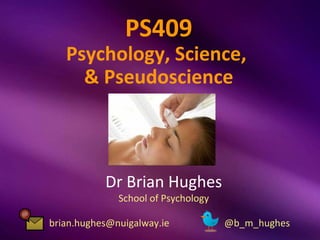
Psychology, Science, and Pseudoscience: Class #12 (CAM cont.)
- 1. PS409 Psychology, Science, & Pseudoscience Dr Brian Hughes School of Psychology brian.hughes@nuigalway.ie @b_m_hughes
- 2. Case Studies: Examples of Psychology-related Pseudoscience
- 3. Case Studies from Outside Mainstream Psychology: 1. Complementary and alternative medicine/therapies
- 4. CAM efficacy: Acupuncture Plausibility issues: Qi, yin, yang, meridians Poor inter-rater agreement Empirical issues: Cochrane Library: 16 reviews 3 reviews for pain: 63 trials; 4,096 participants No effect 1 review for smoking cessation: 24 trials No effect
- 5. CAM efficacy: Acupuncture Adverse effects (Noeheim & Fonnebo, 1995; Yamashita et al., 1998) Exaggerations? Anaesthesia Chinese authenticity vs. Western romanticism Impact on health in China Endorsement by health insurers Actuarial logic rather than concern for efficacy Endorsement by medical authorities Populism or evidence?
- 6. CAM efficacy: Acupuncture Ireland China India Cuba Annual health $2,496 $278 $82 $251 spend per capita* Life expectancy 75/81 70/74 61/63 75/80 (M/F), yrs Child mortality 7/5 27/36 81/89 8/7 (M/F), per 1000 Adult mortality 105/60 158/99 275/202 131/85 (M/F), per 1000 TB cases, per 11 101 168 10 100,000 Last polio case 1965 1999 2006 1962 reported *“International Dollars” = US dollars, corrected for purchasing power parity (i.e., figure shown refers to amount purchased in terms of US market values) Source: WHO
- 7. CAM efficacy: Acupuncture “Approved” by the BMA Reasons given: Popularity among physicians Popularity among public Reported efficacy for, e.g., back pain (citing Ernst & White, 1998) 2000
- 8. CAM efficacy: Chiropractic Plausibility issues: Form-function relationship, subluxations, bodily intelligence, homuncularity Empirical issues: Cochrane Library: 1 review Dysmenorrhoea 5 trials, 236 participants No effect Other frequently cited review: Shekelle et al. (1992) No chiropractic among successful trials
- 10. CAM efficacy: Chiropractic Other reviews Pain: Ernst (2003); Gay et al. (2005); Lisi et al. (2005) 50 trials No effect Asthma: Ernst & Harkness (2001) 2 separate studies No effect
- 11. CAM efficacy: Chiropractic Cost-benefit analysis? Adverse effects of chiropractic 1 per 2 million manipulations (Powell et al., 1993) 1 per 400,000 manipulations (Dvorak, 1985)
- 12. Placebos Inert substances that cause symptom relief “My headache went away after having a sugar pill” Substances/procedures that cause changes in a symptom not directly attributable to specific or real pharmacological/curative action “My headache went away after I had my hip operation” Any therapy that is deliberately used for its non- specific psychological or physiological effects “My headache went away after I had my bath” After Ogden (2004)
- 13. Placebos Patient characteristics Treatment characteristics Convincingness e.g., ultrasound for pain (Hashish et al., 1988) Seriousness e.g., placebo heart surgery (Cobb et al., 1959; Diamond et al., 1960) Patient-treatment interaction characteristics Expectancy effects e.g., Beta-blocker Trial (Horwitz et al., 1990)
- 14. Acupuncture placebos: Sham needles
- 17. PS409 Psychology, Science, & Pseudoscience Dr Brian Hughes School of Psychology brian.hughes@nuigalway.ie @b_m_hughes
